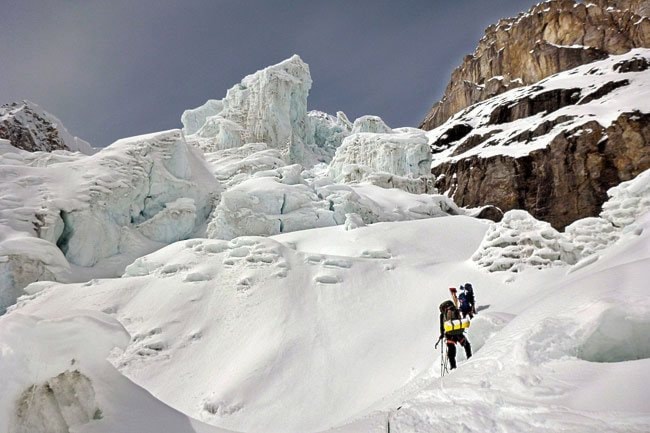‘It’s never an adventure until something goes wrong,” said Saskatoon’s Steve Whittington.
There was plenty of adventure to be had last week on Mount Saskatchewan in Kluane National Park.
Four climbers from the Alpine Club of Canada’s Saskatchewan chapter failed to reach the summit of the only unconquered peak in the Centennial Range, about eight kilometres from the Alaska border.
“We were constantly faced with the worst kind of situation we had planned for,” said Whittington, the team leader. “Every step we took up that mountain had increased consequence.”
The unclimbed mountain is 3,500 metres tall. That’s 2,459 metres shorter than Canada’s highest mountain, Mount Logan, which is also located in the Kluane park.
The Saskatchewanians’ attempt was the fourth ever. There were three previously unsuccessful attempts in 1967, 2005 and 2007.
The team had no problem getting to their starting point at the foot of Prairie Glacier by helicopter. But the glacier turned out to be much more difficult to traverse than expected. The team had to zigzag around obstacles like crevasses, turning a five-kilometre journey up the glacier into a 12-kilometre one.
When returning to get some gear, the team’s lead navigator and medic, Jeffrey Dmytrowich, fell into a crevasse but managed to get out unscathed.
“That gave us a bit of a wake-up call that something was going on with this mountain,” said Whittington.
The four climbers decided to climb an icefall, a section of rapid movement on the glacier, instead of a slope with avalanche danger.
They climbed at night when the icefall was frozen-up and safer. The team completed the climb twice over the night, making two trips to transport their equipment to their base camp.
“We were then in striking range of the summit,” said Whittington.
After a day’s rest, the team began their first summit attempt at 2 a.m., reaching 3,200 metres. But the weather began to turn and the team headed back down the camp, chalking up the attempt to a scouting mission.
The next day they tried again, but conditions were continuing to work against them.
“The rock quality was just terrible; it was just crumbling off in your hands, you couldn’t make safe anchors. The snow was sugary - not stable - but we continued to fight our way up,” said Whittington.
“We’re about 1,200 feet above our high camp and I say, ‘Avalanches usually start about two and it’s one in the afternoon, so let’s try this slope out. So I take a step on this slope and it goes ‘whomph’ and the whole slab breaks and cracks and depresses.”
The team decided to dig a trench and hunker down for six or eight hours to wait for the snow to consolidate. That decision turned out to be a good one. Shortly after they dug the trench, a storm, which they didn’t see coming, hit.
“It was a blizzard and we lost visibility,” said Whittington. “We couldn’t move down because of avalanches, but we had compounding dangers occurring ... People might get frostbite on their toes and it’s going to be an uncomfortable night.
“The other side of it is, with a blizzard, you’re going to lose your tracks.”
The loss of tracks would make it difficult to find their way back to their camp. That would also dramatically increase the danger of crossing the motte (where the glacier breaks away from the mountain).
It was a bad situation and neither choice - staying in the trench or climbing down to the camp - was a good one.
Luckily, they waited out the worst of the storm and managed to find their tracks. But the snow kept coming for three more days, trapping the team at high camp.
Not knowing how long they’d be immobilized by the weather, they began rationing food.
On May 26, a week after beginning the climb, Whittington made the decision to call off the summit attempt and focus on getting off the mountain safely.
“That became the new objective,” said Whittington. “We’re in a whiteout, we have a limited amount of food, we’re rationing food now, we still have to go down a severe avalanche-slope that has now been snow-loaded by a blizzard for three days, we have all these crevasses that we’ve fallen in ... So on Sunday we did a scouting mission and tried to find a safe way down the mountain.”
They made it down to 2,300 metres, but continuing poor condition didn’t allow for them to be picked up by the chopper. Finally, they were picked up by helicopter on May 31.
“Kudos to out pilot, Doug Makkonen from TransNorth (Helicopters),” said Whittington. “He’s an exceptional guy and he did everything he could to safely come and get us.”
Also on the four-person team were Sam Unger, the team’s lead technical climber, and Wren Rabut.
The Centennial range features mountains named after every province and territory in Canada, with the exception of Nunavut, which had not yet been formed in 1967 when the mountains were named in celebration of the nation’s centennial. (There is also a Mount Saskatchewan in Banff National Park in Alberta.)
Whittington can’t say when, but he intends to give Mt. Saskatchewan another crack.
“There’s been five mountains now that I haven’t summitted on the first crack. The other four I’ve gone back and climbed them,” he said.
“We’re not disappointed we didn’t summit. Obviously, summitting would have been more impressive to the world… (But) I’ve always learned more from not summitting than summitting.”
Contact Tom Patrick at
tomp@yukon-news.com
